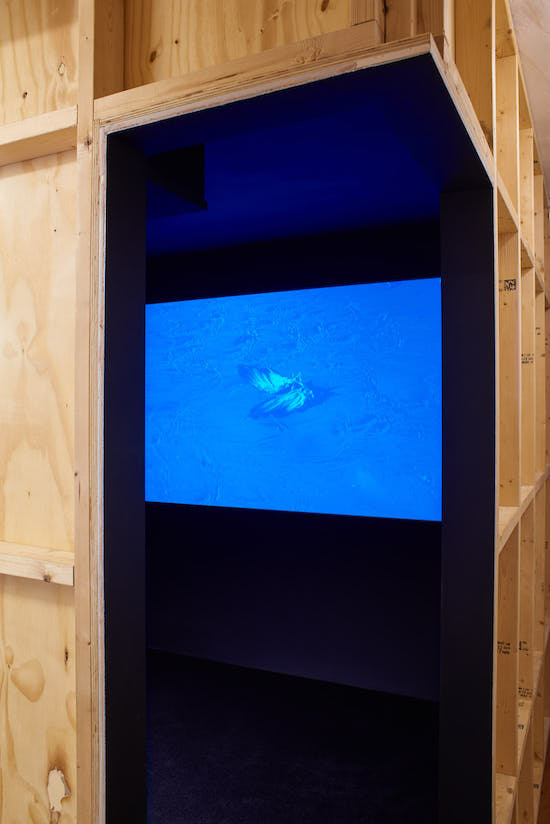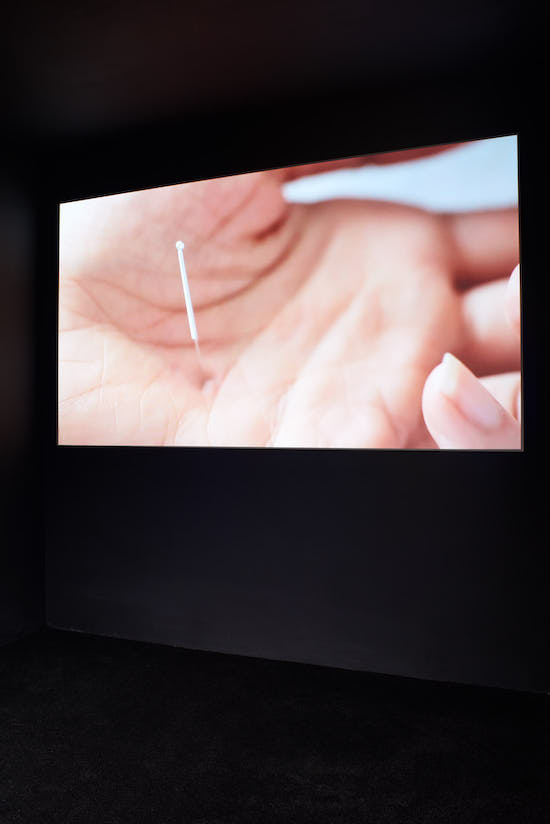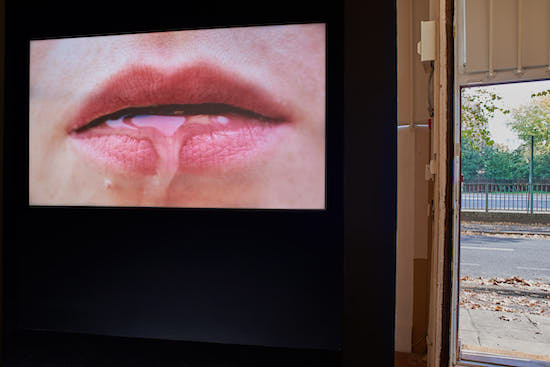WORDS ARE ANGULAR SHARP, TENANT, an exhibition of new audiovisual works nu Rebecca Lennon debuted at Matt’s Gallery (Bermondsey, London) in October of 2018 as part of their series of ten day exhibitions. Lennon’s piece runs in a loop, made up of a series of repeating, evolving video panels and a rhythmic, repetitive audio track.
My immediate impression of the piece was to view it as a sort of ritual, creating symbols as it plays. Circles figure heavily, with the shape represented throughout the video, the audio panning around the space in stereo creating the impression that the sound was being generated in three dimensions. There is an important distinction, in my opinion, between a piece of work designed to loop and a film shown on repeat. Having watched multiple runs of WAAST, this felt integral to the power of the work. The rhythm builds across each loop, breaking, dialling into our internal tempo and adjusting. The repetition of the images brings them to a point of appearing almost sigil-like, relationships between them that may have seemed initially simple become esoteric and diffuse. The viewer is given the responsibility of connecting them.
The audio portion of the work consists of Lennon’s voice, creating tones, building its presence within the work as a force of disharmony – almost beginning to sound like feedback until silence is enacted by an acupuncture needle breaking the skin. Sections of stories, floating memories of acts of aggression – “When I was young, maybe even 10, a group of teenagers punched me in a circle. I remember being impressed by the cleanness of the act, how visual it was, how choreographed it was, as they swung at me one by one until the whole circle released–”
Pinned together by gesture, arms moving in and out of frame, building structures with bodily contortions. Fingers overlap, like shadow puppets with no shadow to cast, building a semiotic language that never fully reveals itself within the work. It feels like a series of opportunities, of firing signals that serve to destabilise the viewer as opposed to emitting a didactic statement.
We watch a mouth fill with water and the water spill out, a mouth fill with toilet paper, protruding, blocking sound from escaping. It feels like Lennon is playing with power, with the semiotic nature of our surroundings. In abstracting – or perhaps exploring – the surreal nature of ourselves and our position, Lennon brings weight to these symbols. She brings weight to words, to the power of speech, to the power of repetition. This theme of power is present throughout the piece, the implication that what you’re viewing is more than the sum of its parts. That you’re present in front of something with knowledge beyond your communication.

Lennon describes her process as making in response to a feeling or impression, not working necessarily with a concrete aim or literal reading of the work in mind, not even working with a complete awareness of how the finished product will appear. This, for me, is part of what allows WAAST to remain an open and engaging piece. The viewer is not precluded from interpretation but the interpretation is not at any point fully validated.
When I arrived at Matt’s to see the show, I asked if the video could be played from the beginning and was essentially told, “that’s not really how it works”. Although I’m almost definitely paraphrasing, that really is an impactful statement in relation to the piece. My first awareness in front of the piece was that I wanted to try to work out where I was in relation to the narrative, I was attempting to position myself in order to seek understanding.
I’m not sure if that’s the correct way to view Lennon’s work. I feel like the improvisational arrangement of the piece lends itself very well to disarming the viewer and allows the work to flow organically. I don’t think it actually matters at all which point you do begin watching the video, although it may have an effect on your internal narrative, that’s not a problem and will not be detrimental to your experience.

In discussing the themes of the work with Lennon, she mentions the ideas of blockage and societal impotence. Their presence within the work is undeniable but not oppressive. I’m not left thinking about my lack of power, or my lack of ability to actualise myself – not thinking about lack at all, in fact.
For me, Words Are Angular Sharp, Tenant rings loudly in the space it occupies, without ever feeling confrontational. A very certain work that is equally certain in its decision not to give itself away, the information remains abstract and the sources distinct. It reminds me almost of watching a film without characters, where the viewer builds narratives or ideas or significances through their own internal dialogue, placing importance on particular scenes, words or tones throughout the piece, led equally by the work and their relationship to the media comprising it.
Words Are Angular Sharp, Tenant was shown as part of a series of ten day exhibitions by Matt’s Gallery in October of 2018. More information about upcoming exhibitions can be found on their website


